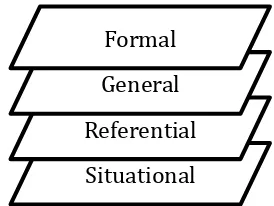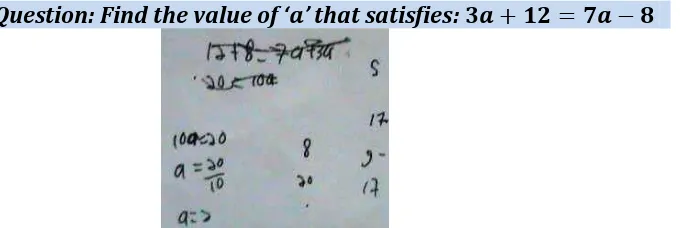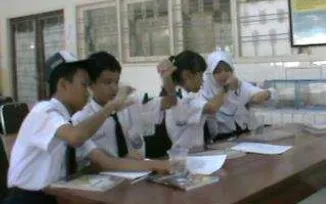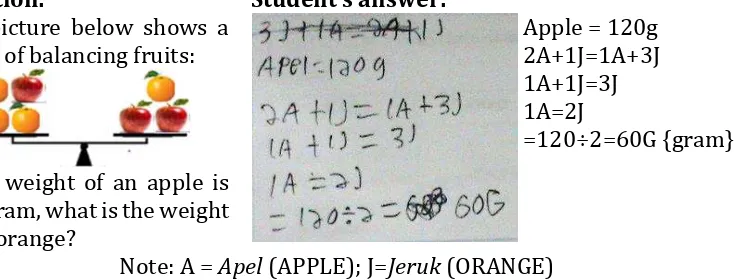ENHANCING STUDENTS’ STRATEGIES T
O SOLVE LINEAR EQUATIONS
WITH ONE VARIABLE THROUGH BALANCING ACTIVITIES
Muhammad Husnul Khuluq1, Zulkardi2, Darmawijoyo3 Sriwijaya University1,2,3
1) husnulkhuluq91@gmail.com, 2) zulkardi@yahoo.com, 3) darmawijoyo1965@yahoo.com
Abstract
One of causes of difficulties that students often encountered when working with problems of linear equations is their inflexibility in employing strategies to solve for an equation. As a consequence, the students might be able to solve a problem easily, but often fail to solve another similar problem. Focusing on this phenomenon, the present study aims to provide a series of lessons that build students’ flexibilities in employing strategies to solve linear equation problems. The study is a design research, which is a preliminary to a larger study. This study is implemented to a small group consisting of four 7th graders of SMP Pusri Palembang. Balancing is chosen as an approach to base the overall design and the promoted solving strategy. This study first revealed a trend of students’ strategies, that is, either unsystematic guess-and-check or (a not meaningful) formal problem solving, that the students used all the time when solving any linear equation problems. During the learning implementation, the students’ strategy started to vary. The balancing activities have helped students to make sense of equalities. The balance was then improving to be a model that helps students perform transformation strategy, which is a more meaningful formal strategy to solve for equations. This shows the applicability of the proposed design to deal with students’ rigidity in solving linear equation problems.
Keywords:Strategies, linear equations, design research, balancing
INTRODUCTION
Growing up perceptions about difficulty of learning algebra among students have likely become issues in many mathematics classrooms, particularly during their secondary school ages. As the consequence, many students became lazy and seemed to avoid mathematics once they have started to learn about this topic (Cai, et al., 2005). The difficulties that students often encountered in their initial algebra learning are categorized into five aspects, such as: working in the process of mathematization, understanding algebraic expressions, applying arithmetical operations in algebra, dealing with equations, and understanding variables (Jupri, Drijvers, & van den Heuvel-Panhuizen, 2014).
it would be very difficult for them to let their students reinvent the idea themselves. In short, those teachers believed that algebra should not be taught in a constructive manner.
In practice, some teachers unfortunately became very strict to students (Whitman in Kieran, 1992). They seemed to force students to a single approach to solve equations, using the formal way. Such decision has been proven to be ineffective, especially in
building up students understanding and visions toward the concepts of algebra
(Whitman in Kieran, 1992). As the result, some students often became too rigid in memorizing rules and employing strategies to solve for equations.
Although a number of studies related to algebra teaching have been performed, few of them (if any) gave practical suggestions that teachers can immediately use to improve their algebra teaching. The studies mostly ended up with identifications of students
difficulties, causes, and how it affect students learning of more advanced topics for a
review, see Booth, 1988; Pillay, Wilss, & Boulton-Lewis, 1998).
Due to this gap, this study is conducted. The goal of this study is to design an innovation in algebra teaching, particularly on strategies the students used to solve problems of linear equation with one variable. In addition, this study also tried to provide theoretical insights in the teaching of the aforementioned topic. Balancing activities will be used to
promote students flexibility in performing strategies to solve problems of linear
equations.
Hence, the research question addressed in this study is: How can balancing activities enhance students’ strategies to solve problems of linear equations with one variable?
THEORETICAL FRAMEWORK
In many curricula, the topic of linear equations with one variable usually becomes an
entrance of students algebra learning. (untley and Terrel (2014) stated that this topic is
really important and has likely become a hallmark of students algebraic proficiency in
school. Focusing on strategies that students might employ when working with linear equation, the literature review in this report is structured in four main parts, such as, the strategy, important mathematical ideas, balancing activity, and Realistic Mathematics Education (RME) that underlies this design.
Strategies to solve linear equations with one variable
Important knowledge to solve for an equation
In order to have a good mastery in solving problems of linear equations with one variable, some basic concepts are required. These four conceptions were mentioned by Linsell (2008) in her study, such as, 1) knowledge of arithmetic structure, 2) knowledge of algebraic notation and convention, 3) acceptance of lack of closure (an ability to hold not to solve a problem directly), and 4) understanding of equality. These four conceptions would likely become key purposes of the designing.
Balancing activities
The use of balancing in learning linear equations has offered some advantages, such as, its meaningfulness in everyday life situations and its similar characteristics with representations of equations (van Amerom, 2002). This somewhat brings benefits to the promotion of transformation strategy. Vlassis (2002) found in his study, that the balance model is an effective tool for conveying the principles of transformation. This is due to the principles applied to create a balance situation on a balance scale really suits the process of solving equations. In this case, the balance scale gives meaningful insights on eliminating the same terms from both sides of an equation to obtain the value of the unknown.
Realistic Mathematics Education (RME)
RME is an innovation in approach of teaching mathematics that holds a view of Fruedenthal of mathematics as a human activity. This approach is first developed in the Netherlands and has been promoted worldwide in some countries. A belief in RME that a learning should start from what is familiar to them required some adjustments especially in the learning environments in the countries adopting it, as what is done in Indonesia (for instance the one by Zulkardi, 2002). This results in the Indonesian version of RME called PMRI (Pendidikan Matematika Realistik Indonesia) or Indonesian RME. Adopting the idea of RME, the implementation of this approach carries out three important principles, such as, guided reinvention, didactical phenomenology, and self-developed models (Gravemeijer, 1994). For the purpose of this study, the third principle would be the main concern. The principle tells how students learning progress from what is familiar for them into a mathematical understanding. This process involves changes in viewing certain contexts as a model of situation into a model for reasoning. This process is illustrated by Gravemeijer (1994) as in figure 1.
Figure 1: Scheme of modeling in RME
Situational Referential General
METHOD
This study is a design research consisting of three phases, such as, 1) preparation and design, 2) teaching experiment, and 3) retrospective analysis (van Eerde, 2013). This study is a preliminary to a larger study. Four students of the 7th grade of SMP Pusri Palembang are involved as subjects (in this report, we used pseudonyms to recall the subjects). In this occasion, the researcher acts as a teacher. A static and a dynamic video recorder were employed to gain complete view of the lesson.
During the first phase, the researcher reviewed literatures, consulted with a classroom teacher, and planned a Hypothetical Learning Trajectory (HLT) for the learning. To gain
more insights about students preliminary knowledge, classroom observation, pretest, and interviews were done prior to the learning. In the second phase, the HLT is tested. In
this phase, data about students learning were gathered in video recordings, students
written works, and field notes. Afterwards, the data were analyzed by reflecting the data on the HLT in the phase of retrospective analysis.
RESULT AND DISCUSSION
Students’ Preliminary Knowledge
Classroom observation and interview with teacher in the beginning of this study revealed a fact that the subject-students have just learned about linear equation weeks before the
implementation. (owever, results of the pretest still showed students lack of
understandings toward the concept.
An important remark from the pretest was the students modest strategies to solve linear equation problems. In this occasion, students mostly relied on the guess-and-check strategy, which is considered the lowest level (Linsell, 2009; see theoretical framework).
This strategy is identified clearly both in students written works and explanations during
the interview session. Expressions like we first guess any numbers , try to find a number that leads to the same result , and using logics, think of a number, and try it out
by most of the students might support this claim.
Some students also have tried to use the formal strategy; however they found difficulties
to deal with changes of values. They seemed to only memorize a rule like: if moving across the equal sign, change value . As a result, a mistake like shown in figure became common.
Question: Find the value of � that satisfies: � + = � −
Other students who succeeded to solve this problem found another struggle, as they needed to work with negative numbers. In this case, they strictly limit themselves to gather the two terms with variables on the left of the equal sign. Here, they proclaimed that putting variables on the right of equal sign was an error and would not lead to a correct answer. This kind of misunderstanding, together with the struggle with value changes, shows inflexibility of students that might be caused by the very formal approach to teach the concept of linear equation (Whitman in Kieran, 1992).
Activity 1 Secret Number
This part focused on arithmetic-related part and algebraic representations. Although this activity is not the balancing activities (not the core activity) yet, a new strategy was revealed by students, that is, working backwards. In this part, students play
guess-my-number and then tried to make their own trick to guess other students guess-my-numbers. The
fragment 1 shows how Anggi has used working backwards strategy in her secret number trick.
Fragment 1: Student s uses of working backwards strategy 1
2 3 4 5 6 7
Anggi
Researcher
Anggi
(Think of a number, add , multiply , divide by , subtract by , and then add ) {initial instructions}
How to find the result then? {the secret number} (miswording, but understandable by the students) The final result is subtracted by 2 {− }… add 2 {+ }… divide by 2.. ehh.. multiply it by 2 {× }… divide by 2
{÷ }… minus 5 {− }
Although this strategy is not applicable for all kinds of equations, it might help students a lot to later gain insights of the transformation strategy. At least, this might add student s references of strategies to solve for equations other than the guess-and-check and the formal one. This perhaps might contribute to her flexibility in employing strategies to solve for linear equation problems.
Activity 2 Balancing Activities Part 1
In the first part of balancing activity, students were asked to combine 3-different-sized marbles (big, medium, and small) on a balance scale. The task was to find as many combinations as they could. An illustration of how this activity went is given in figure 3.
During this activity, students sense of balancing conditions is stimulated. They are let to
experience and observe equalities in a real situation. This notion is important, since it is
meant to be a basis their balancing strategy later on. From this activity, students have
found a list of combinations that result in a balance.
An interesting conversation between Bagus and Sabil (given in fragment 2) was found in the middle of their works. This conversation gives an indication of students awareness of quantitative relations.
Fragment 2: Students started to think of quantitative relations
(After finding a combination of 9 small = 1 big, Bagus and Sabil tried to find another combination. Sabil first put 2 big marbles on an arm and some small marbles on the other arms of the balance scale)
1
[add small marbles until he thought it was balance] [change his hand with a hook to hold the balance scale] [put the balance scale on his table, and then raised it slowly. He observed it] [put the balance again, and again raised it] [he observed and found it balance]
[counting silently] 11, 12, 13, 14, 15, 16, 17, 18, 19.
Despite the correctness of the results that the two students found, it seemed that Bagus had started to think about moving from a certain combination to another combination. He had started to think about the quantitative relations among objects in a way that a balance condition must have relation with the other balances. This indicator confirmed our HLT on how the activity builds students sense of quantities in balancing activities. Further, this understanding could grow to be a model of for students once they found problems of equal balances.
Part 2
In the second part, students were provided with list of balance combinations they have found from the previous activity. The task was to find more combinations that also balance without tools anymore. This activity forces students to think of relationships among balanced situations. The provided balanced combination is given in figure 4.
Symbol explanation: B = Besar (BIG)
S = Sedang (MEDIUM) K = Kecil (SMALL)
Figure 4: List of the provided balance combinations
Fragment 3: Student s strategy to maintain balance
The number 2 here is 2 medium equals 5 small; which means, if we double it; 4 medium is equal to 10 small ones.. )sn t it?
(mm… are you sure it is right?
[mumbling]
Why do you think if it is doubled, then it is still balance?
(mm.. )sn t it balance from here? So, if we add with
another balanced combinations, it is still balance..
As shown in fragment 3, the student has figured out that a balance situation can be maintained by doubling. Here, she could explain that combining two balance situations will give a new balance combination. In addition to this finding, a number of strategies to maintain balance were revealed during this study, such as, multiplying with constant, adding another balance, adding and subtracting with similar objects, and exchanging
positions. Moreover, a quite advanced strategy substitution was also revealed, as can
be seen in fragment 4.
Fragment 4: Students use substitutions to find a new balance combination 1
Although Sabil and Bagus have not used the terminology substitution , it is clear from the fragment 4 in line 8 that they have substituted � = . into = � + to find =
+ = . This shows a high level of flexibility and the acceptance of lack of closure, which is a big step to understanding of transformation strategy.
Part 3
(a) (b)
Note: K = Kecil (SMALL); S = Sedang (MEDIUM); B=Besar (BIG)
Figure 5: Students strategy to find the weight of the medium and big marbles
As we can observe in figure , students tendency to guess-and-check is completely diminished. They, with no doubt, substituted the value of an unknown into the equation to find the value of the other unknown. Inverse operation is also observable in figure 5a, which was likely similar to working backwards promoted in the first part of the lesson.
Student’s strategy after the balancing activities
After the series of learning, a test was given to student-subjects. This was to observe
students understanding about linear equations as well as to check their readiness for a
more formal level of algebra. In this test, students performed different strategies to solve problems of linear equations, such as, guess-and-check, substituting, and eliminating.
The figure shows a question and an example of a student s answer Bagus when solving
the problem.
Question:
The picture below shows a result of balancing fruits:
If the weight of an apple is 120 gram, what is the weight of an orange?
Student’s answer:
Apple = 120g 2A+1J=1A+3J 1A+1J=3J 1A=2J
=120÷2=60G {gram}
Note: A = Apel (APPLE); J=Jeruk (ORANGE)
Figure 6: A question and an example of student s strategy to solve the problem
CONCLUSION
Based on the results and discussions, it is observable that balancing activities have helped students to improve their strategies to solve linear equations with one variable. This improvement covers their flexibility in manipulating equations and the various strategies they used to solve for equations.
Balancing activities first helped students to make sense of equality from the balance. This grew to be a model of situations for students on which they might reflect every situations involving balance. Balancing activities also stimulated students to think of quantitative relations among objects, so they could be more flexible in manipulating the balance, as such, the equations represented in the balance as well.
The smooth shifts from pure objects into objects that have value (weight) in the balancing activities help students to minimize differences between objects and values in an equation. Thus, they can do substitution of certain values to objects freely.
ACKNOWLEDGEMENTS
The first author is an awardee of International Master Program on Mathematics Education (IMPoME) granted by Indonesian Directorate General of Higher Education (DIKTI) in cooperation with Nuffic Neso. We also thank Mieke Abels, Maarten Dolk, Dolly van Eerde, and Frans van Galen from Fruedenthal Institute for Science and Mathematics Education, Utrecht University, the Netherlands, for their great contribution to this paper.
REFERENCES
Booth, L. . Children s difficulties in beginning algebra. )n A.F. Coxford & A.P. Shulte (Eds.), The Ideas of Algebra, K-12. 1988 Yearbook (pp.20–32). Reston, VA: The National Council of Teachers of Mathematics.
Cai, J., Lew, H.C., Morris, A., Moyer, J.C., Fong, S., & Schmittau, J. (2005). The development
of students algebraic thinking in earlier grades: a cross-cultural comparative perspective. ZDM, 37, 5-15.
Gravemeijer, K. (1994). Developing Realistic Mathematics Education. Utrecht: CD-β Press. Huntley, M.A., & Terrel, M.S. (2014). One-step and multi-step linear equations: a content
analysis of five textbook series. ZDM Mathematics Education, 46, 751–766.
Jupri, A., Drijvers, P., & Van den Heuvel-Panhuizen, M. (2014). Difficulties in initial algebra learning in Indonesia. Mathematics Education Research Journal. DOI: 10.1007/s13394-013-0097-0.
Kaput, J. J. (2000). Teaching and learning a new algebra with understanding (SE 063 387). Washington DC: National Science Foundation. (ED 441 662).
Kieran, C. (1992). The learning and teaching of school algebra. In D. A. Grouws (Ed.), Handbook of Research in Mathematics Teaching and Learning (pp. 390–419). New York: Macmillan.
Linsell, C. . Solving equations: students algebraic thinking. )n Findings from the New Zealand Secondary Numeracy Project 2007 (pp. 39–44). Wellington: Learning Media.
Linsell, C. (2 a . Students knowledge and strategies for solving equations. )n Findings from the New Zealand Secondary Numeracy Project 2008 (pp. 29–43). Wellington: Learning Media.
Linsell, C. (2009b). A Hierarchy of strategies for solving linear equations. In R. Hunter, B. Bicknell, & T. Burgess (Eds.). Crossing Divides: Proceeding of the 32nd Annual Conference of the Mathematics Education Research Group of Australia (vol.1). Palmerston North, NZ: MERGA.
Pillay, H., Wilss, L., & Boulton-Lewis. (1998). Sequential development of algebra knowledge: A cognitive analysis. Mathematics Education Research Journal, 10, 87– 102.
Rosnick, P., & Clements, J. (1980). Learning without understanding: The effect of tutoring strategies on algebra misconceptions. Journal of Mathematics Behavior, 3, 3–27. Van Amerom, B. (2002). Reinvention of Early Algebra: Developmental Research on the
Transition from Arithmetic to Algebra. Utrecht: CD-β Press.
Van Eerde, H.A.A. (2013). Design research: looking into the heart of mathematics education. In Zulkardi (Ed.) Proceeding the First South East Asia Design/ Development Research (SEA-DR) International Conference (pp. 1-11), Sriwijaya University, Palembang, April 22nd – 23rd.
Vlassis, J. (2002). The balance model: hindrance or support for the solving of linear equations with one unknown. Educational Studies in Mathematics, 49, 341–359. Zulkardi. (2002). Developing a learning environment on Realistic Mathematics Education



